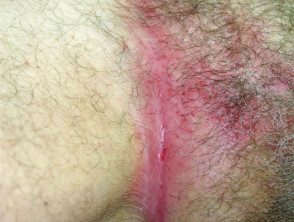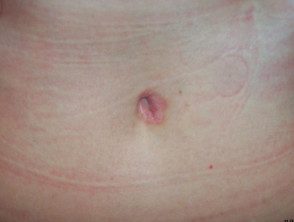Psoriasis is common scaly skin condition resulting in red patches of thickened, scaly skin. Flexural Psoriasis is sometimes called reverse psoriasis and describes psoriasis located to the folds of the skin and genitals. Common sites of flexural psoriasis are:
- Armpits
- Groin
- Under the breasts
- Belly button (belly button)
- Penis
- Vulva
- Native cleft (between the buttocks)
- Around the anus
Many patients have psoriasis that affects other sites, particularly within the ear canal, behind the ears, through the scalp, and on the elbows and knees.
Flexural psoriasis

Flexural psoriasis

© Dr. Ph Abimelec -

Flexural psoriasis
-
See more images of flexural psoriasis ...
-
See more images of genital psoriasis ...
Clinical characteristics of flexural psoriasis.
Due to the moist nature of the skin folds, the appearance of psoriasis is slightly different. Tends not to have silver scale, but it is shiny and smooth. There may be a crack (fissure) in the depth of the skin fold. The deep red color and well defined The characteristic edges of psoriasis can be obvious.
Scaly plates However, it can sometimes occur, particularly on the circumcised penis.
Flexural psoriasis can be difficult to distinguish from seborrheic dermatitisor it can coexist. Seborrheic dermatitis in the skin folds tends to present as thin salmon pink patches that are less defined than psoriasis. If there is any doubt as to who is responsible, or it is believed that there is an overlap of the two conditions, the term sebopsoriasis can be used.
Complications of flexural psoriasis include:
- Rubbing and irritation from heat and sweat.
- Secondary fungal infections, particularly Candida albicans (thrush)
- Lichenification (a kind of eczema) from rubbing and scratching: this is a particular problem around the anus where the stool irritates causing itching
- Sexual difficulties due to embarrassment and discomfort.
- Thinned skin due to long-term overuse of strong current steroid creams
What is the treatment for flexural psoriasis?
Flexural psoriasis responds fairly well to topical treatment, but often recurs.
Topical steroids
Weak topical steroids (often in combination with an antifungal agent to fight candidiasis) can eliminate psoriasis on flexion, but will generally recur sometime after stopping treatment. The strongest topical steroids should be used with care and only for a few days, applied finely and very precisely to psoriasis. If the psoriasis is gone, stop the steroid. cream. The steroid cream can be used again in the short term when the condition recurs.
Overuse of topical steroids in thin skin body folds can cause stretch marks, marked thinning of the skin, and can lead to long-term aggravation of psoriasis (tachyphylaxis).
Vitamin D-like compounds
Calcipotriol cream is an effective and safe treatment for psoriasis in the push-ups and must be applied twice a day. If it irritates, it can be applied once a day and hydrocortisone cream 12 hours later.
Topical calcineurin inhibitors.
Topical calcineurin inhibitors Tacrolimus ointment and pimecrolimus cream can be effective and does not cause thinning of the skin.
Combinations of the treatments listed above can be used in conjunction with emollients. Antiseptics and topical antifungal agents are often recommended since flexural psoriasis can be complicated by bacteria and yeasts, including Candida albicans and Malassezia.
Strong topical agents
Treatments that are tolerated elsewhere are often too irritating to use on skin folds, for example dithranol, salicylic acid, and coal tar. However, it may be possible to use them by diluting them in emollients, or applying them for short periods and washing them.
Systemic Agents are rarely required for limited flexural psoriasis, and phototherapy is relatively ineffective because the folds are hidden from light exposure.

